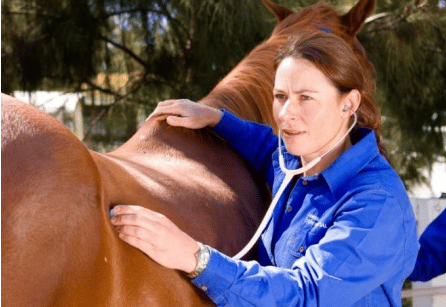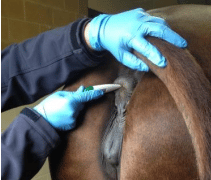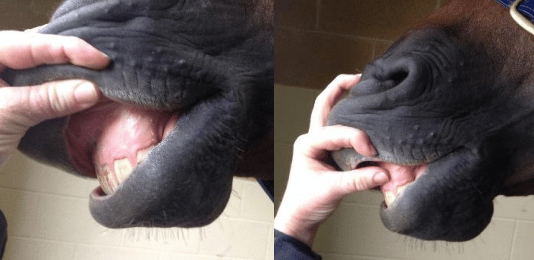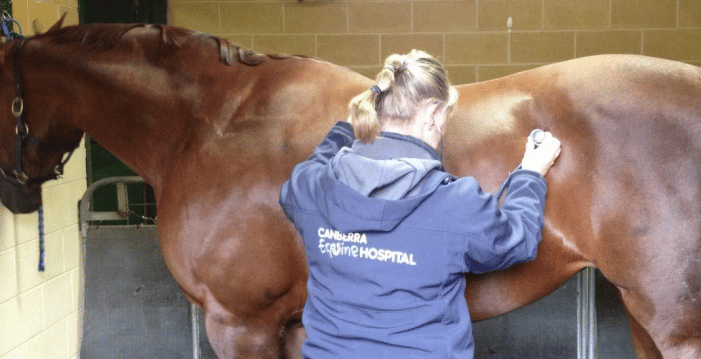 Do you know your horse’s normal vital signs? Vital signs include your horse’s resting heart rate, breathing rate and temperature. A variation in your horse’s vital signs can indicate he or she is suffering pain or disease.
Do you know your horse’s normal vital signs? Vital signs include your horse’s resting heart rate, breathing rate and temperature. A variation in your horse’s vital signs can indicate he or she is suffering pain or disease.
If your horse seems unwell or appears to have unusual behaviour, it’s always helpful to perform a quick vital signs check. Ask our dedicated and highly skilled equine nurses if you’re unsure what to look for.
Normal vital signs for adult horses (at rest):
- Heart rate 38-44 beats per minute
- Rectal temperature 37-38.5ºC
- Respiratory (breathing) rate 12-20 breaths per minute
- Gums should be light pink and moist, and capillary refill time less than 2 seconds
- Sounds of the intestines should be heard on both sides of the abdomen
- 6-10 manures and 3-4 urinations should be passed every 24 hours
- A 500kg thoroughbred-sized horse drinks 20-25 litres every 24 hours
How to find your horse’s vital signs:
Your horse should always be safely restrained while taking vital signs. Some horses may become fidgety during parts of this examination, so extra care should be taken. So you can pick up when something may be wrong, learn your horse’s normal vital signs when at rest, and after exercise.
Heart Rate (HR):
Place the flat side of the stethoscope head behind your horse’s left elbow, in front of where your girth would sit. Count each “lub-dub” sound as one beat.
Normal resting heart rate: 38-44 beats/minute

Temperature:
Lubricate your thermometer (eg with KY Jelly). Stand safely to the side of your horse’s rump. Gently but firmly hold the tail at the base, and lift it to one side. Insert the thermometer into the anus, holding it firmly flat against the wall of the rectum. When the thermometer indicates it has finished reading, remove it and record the reading.
Normal temperature: 37-38.5ºC
Respiratory Rate (RR):
Watch your horse’s flank and rib cage rise and fall as he/she breathes. Count each inhalation (breathe in) and exhalation (breathe out) together as one breath. You can also listen for the respiratory rate with your stethoscope, or watch the flare of the nostrils.
Normal resting respiratory rate: 12-20 breaths/minute

Oral Mucous Membranes:
Lift your horse’s lips to show the gums – what colour are they? If they are any shade of purple, blue or red, call us urgently. Feel the gums with your finger tip – do they feel moist, or dry? Press your finger firmly against the gum, then release. You will notice under the pressure of your finger, the gum is almost white when you remove your finger, but then the colour returns. Watch to see how long the gum colour takes to return to normal. This is known as the capillary refill time (CRT).
Normal gums: Light pink colour, and moist to touch
Capillary refill time: Less than 2 seconds

Abdominal Sounds:
Listen with the stethoscope on each side of your horse’s abdomen, above and below the flank area. The sounds you hear will vary, and can be described as gurgling, rumbling, tinkling, gaseous etc. Sounds also vary in frequency and loudness, depending on which area you listen to. You should always be able to hear sounds in all quarters if using a stethoscope, however with the naked ear they may be difficult or unable to be heard.
Remember, if you are concerned about your horse at any time of day or night, we have our team of dedicated equine vets and nurses on call 24 hours a day, seven days a week.
